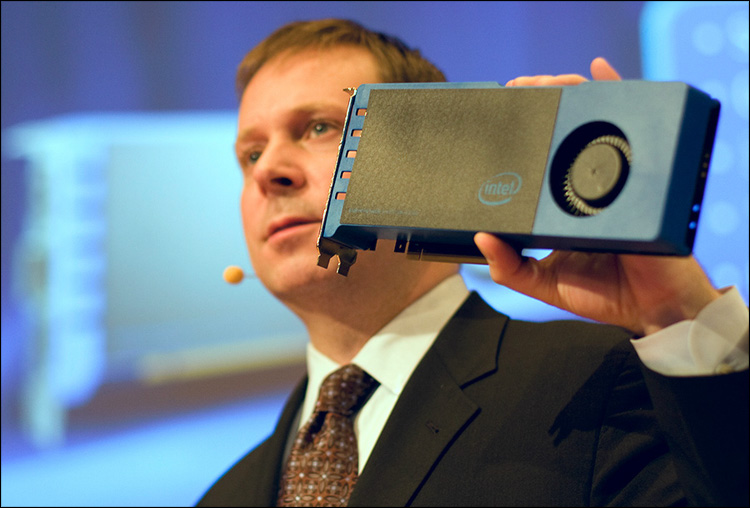The future of supercomputer computing
The day before the beginning of the calendar summer, the International Supercomputing Conference (ISC) was held in Hamburg, at which Intel announced its intention to launch the new Intel Super Integrated Core Computer Architecture (MIC).

Thanks to a new product, systems based on it will be able to perform calculations at a speed measured in trillions (!) Of operations per second!
In fact, the architecture of Intel MIC is the result of three areas of development, such as:
')
- 80-core experimental processor of the Terascale research project
- Experimental Cloud Computing Processor (SCC), codenamed Rock Creek
- Multi-core graphic calculator Larrabee
Kirk Skaugen (Kirk Skaugen, director of data center solutions group), who was already familiar to us from the relatively recent announcement of the Intel Xeon processors, spoke about all this. By the way, it is from these processors that the MIC architecture consists, and with them the new specialized multi-core coprocessors, which are based on Larrabee, Rock Creek and the multi-core processor of the Terascale project. The first such coprocessor will appear in the foreseeable future and will be manufactured (following Moore's law) using Ivy Bridge's 22-nanometer technology, and the name will be no less beautiful - Knights Corner (consisting of more than 50 cores). No, you imagine that the transistor (the brick from which the processor is built) has a size of 22 billionths (!) Meters. On the other hand ... after all, it is not manually soldered :)

Kirk holds in his hands the silicon plate of memory already manufactured by the 22-nanometer process technology.
In addition to financial costs, supercomputer projects require a significant amount of time, so Intel is already beginning to supply a specialized development kit for Knights Corner systems with another unusual name - Knights Ferry. For example, scientists from CERN (the European Center for Nuclear Research, known for its large hadron collider), were able to transfer a rather complicated benchmark written in C ++ to a new architecture in just a few days.

Kirk Shows Knights Ferry
The petaflop barrier was taken last year, and the exoflop generation of supercomputers is still ahead (work on the ExaCluster Laboratory to create them is already underway with the European center Forschungszentrum Julich). And in order that all our plans could be fully utilized, Intel has updated the Intel Cluster Toolkit Compiler Edition 4.0 software package, which consists of a set of tools for optimizing high-performance computing and multi-core systems.
Where might such performance be needed?

It is clear that they are not at home for toys ... but to look a little wider is just a great many applications, especially considering the total computerization of everything and everyone. But as before, such systems will be designed primarily for high-performance computing, such as geological and environmental surveys, processing of data from scientific experiments (yes, take the same collider), climate modeling and other financial operations.
Successes!

Thanks to a new product, systems based on it will be able to perform calculations at a speed measured in trillions (!) Of operations per second!
In fact, the architecture of Intel MIC is the result of three areas of development, such as:
')
- 80-core experimental processor of the Terascale research project
- Experimental Cloud Computing Processor (SCC), codenamed Rock Creek
- Multi-core graphic calculator Larrabee
Kirk Skaugen (Kirk Skaugen, director of data center solutions group), who was already familiar to us from the relatively recent announcement of the Intel Xeon processors, spoke about all this. By the way, it is from these processors that the MIC architecture consists, and with them the new specialized multi-core coprocessors, which are based on Larrabee, Rock Creek and the multi-core processor of the Terascale project. The first such coprocessor will appear in the foreseeable future and will be manufactured (following Moore's law) using Ivy Bridge's 22-nanometer technology, and the name will be no less beautiful - Knights Corner (consisting of more than 50 cores). No, you imagine that the transistor (the brick from which the processor is built) has a size of 22 billionths (!) Meters. On the other hand ... after all, it is not manually soldered :)

Kirk holds in his hands the silicon plate of memory already manufactured by the 22-nanometer process technology.
In addition to financial costs, supercomputer projects require a significant amount of time, so Intel is already beginning to supply a specialized development kit for Knights Corner systems with another unusual name - Knights Ferry. For example, scientists from CERN (the European Center for Nuclear Research, known for its large hadron collider), were able to transfer a rather complicated benchmark written in C ++ to a new architecture in just a few days.

Kirk Shows Knights Ferry
The petaflop barrier was taken last year, and the exoflop generation of supercomputers is still ahead (work on the ExaCluster Laboratory to create them is already underway with the European center Forschungszentrum Julich). And in order that all our plans could be fully utilized, Intel has updated the Intel Cluster Toolkit Compiler Edition 4.0 software package, which consists of a set of tools for optimizing high-performance computing and multi-core systems.
Where might such performance be needed?

It is clear that they are not at home for toys ... but to look a little wider is just a great many applications, especially considering the total computerization of everything and everyone. But as before, such systems will be designed primarily for high-performance computing, such as geological and environmental surveys, processing of data from scientific experiments (yes, take the same collider), climate modeling and other financial operations.
 By the way, since we started talking about HPC) Twice a year, experts from the Computing Center of the US Department of Energy (US Department of Energy National Energy Research Scientific Computing Center) rank the 500 most powerful supercomputers in the world . According to the 35th edition of the list announced at ISC, Intel remains the leading supplier of solutions for supercomputers: 408 systems included in the list (which is almost 82%) are built on Intel processors. Moreover, the "stones" of the Intel Xeon 5500 series now work in 186 systems against 95 in the previous edition of the rating. By the way, since we started talking about HPC) Twice a year, experts from the Computing Center of the US Department of Energy (US Department of Energy National Energy Research Scientific Computing Center) rank the 500 most powerful supercomputers in the world . According to the 35th edition of the list announced at ISC, Intel remains the leading supplier of solutions for supercomputers: 408 systems included in the list (which is almost 82%) are built on Intel processors. Moreover, the "stones" of the Intel Xeon 5500 series now work in 186 systems against 95 in the previous edition of the rating. |
Source: https://habr.com/ru/post/95178/
All Articles